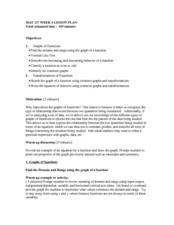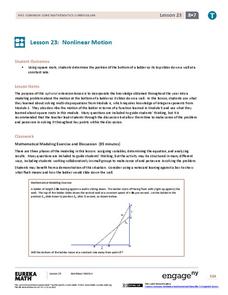Curated OER
Hot Cans and Cold Cans
Students investigate the physics of heating and cooling through conduction, convection, and radiation. Working in groups, they determine the best way to cool a can of water and warm a can of water. Temperature is taken at five minute...
Curated OER
Telling Time
Students practice telling time using five and ten minutes intervals. They use their arms and bodies to show the time while following teacher led instructions. They go through the motions as a whole class.
Curated OER
To The Clock of Eras
Third graders investigate the events of geological time using a chart called a "Clock of Eras". In this geological events lesson plan, 3rd graders compare a standard clock to a geological clock. In addition, students consider periods...
Chicago Botanic Garden
Historical Climate Cycles
What better way to make predictions about future weather and climate patterns than with actual climate data from the past? Young climatologists analyze data from 400,000 to 10,000 years ago to determine if climate has changed over...
Curated OER
Team Up for Telling Time
Students team up to compete in a variety of Internet time-telling activities. In teams of four, groups are assigned to computers and solve problems related to telling time.
EngageNY
Interpreting Quadratic Functions from Graphs and Tables
Seeing functions in nature is a beautiful part of mathematics by analyzing the motion of a dolphin over time. Then take a look at the value of a stock and maximize the profit of a new toy. Explore the application of quadratics by...
Curated OER
Coloring Interval Graphs
Students investigate planning an activity and getting it done on time. In this algebra lesson, students define vocabulary words related quadratic equations, including the vertex and intervals. They figure a good way to color graphs...
Curated OER
Graphs and Transformations of Functions
Is it possible to solve quadratic equations by factoring? It is, and your class will graph quadratic equation and functions too. They perform transformation on their graphs showing increasing and decreasing intervals, domain, and range....
Curated OER
Cell Energy-Bubbling Plants
Middle schoolers discuss the process of photosynthesis in plants and that oxygen is produced as a by product. They observe underwater Elodea plants "breathing" in a hands-on activity. After setting up the experiment, they observe the...
Curated OER
Cool Liquids
Chemistry neophytes use a temperature probe to assess the change as five different liquids evaporate. The implantation section suggests that they take readings every five seconds for a total of four minutes. They graph the data, look up...
Curated OER
Weather With a Latitude
Students read the temperature from a thermometer. In this weather instructional activity, students read a thermometer and record the temperature at twenty minute intervals. Students discuss results.
Curated OER
Alfy plays "Time Flies"
Third graders use the Internet to go to a math web site to explore, practice and play time telling exercises. They play a time game by moving the clock arms to match a time presented on a button.
Curated OER
What Time Does the Last Worker Report?
Third graders explore the concepts of time and consumer goods. In this telling time lesson, 3rd graders respond to questions about the passage of time and goods and services. This lesson incorporates the use a video titled...
EngageNY
Two Graphing Stories
Can you graph your story? Keep your classes interested by challenging them to graph a scenario and interpret the meaning of an intersection. Be sure they paty attention to the detail of a graph, including intercepts, slope,...
EngageNY
Margin of Error When Estimating a Population Mean (part 1)
We know that sample data varies — it's time to quantify that variability! After calculating a sample mean, pupils calculate the margin of error. They repeat the process with a greater number of sample means and compare the results.
Curated OER
Topographic Map Unit Plan
Learners examine topographic maps and discover how to decipher contour intervals, use contour lines and apply information to complete a topographic map lab. Working in groups, they identify the scale of the map, latitude and longitude,...
Curated OER
Rehearsal and Sightreading Techniques
Eighth graders prepare the two pieces "American Celebration" and "Patriotic Bits and Pieces" for an upcoming performance. This lesson is a forty-five minute lesson geared towards a middle school advanced band (8th Grade). National and...
Curated OER
Time Flies When Math Is Fun
Third graders pracdtice telling time with a demonstration clock.
EngageNY
Graphs of Simple Nonlinear Functions
Time to move on to nonlinear functions. Scholars create input/output tables and use these to graph simple nonlinear functions. They calculate rates of change to distinguish between linear and nonlinear functions.
EngageNY
Nonlinear Motion
Investigate nonlinear motion through an analysis using the Pythagorean Theorem. Pupils combine their algebraic and geometric skills in the 24th lesson of this 25-part module. Using the Pythagorean Theorem, scholars collect data on the...
Curated OER
Dead Body Math
Students solve the mystery of dead Mr. Potato Head using physics and algebra. They discuss Newton's Law of cooling as it applies to the mystery scenario involving a cooling baked potato as the "victim". They manipulate algebraic...
Curated OER
Writing a Plan
Third graders pick something interesting to do, and write a plan to do it. They are guided inwardly to understand how long a short period of time is. Do this with a countdown of 5 minutes, in 1-minute intervals. This is the 5 minutes...
Curated OER
Leisure Skills
Students investigate the skill of self initiating a leisure skill using a choice training procedure. The training is done in short intervals of about five minutes each. The behavior is reinforced and the goal is to keep it sustained....
Curated OER
Simple Inequalities on a Number Line
Young scholars solve inequalities problems. In this algebra lesson, students graph the solution of inequalities on a number line. They discuss boundaries and open or closed intervals.























